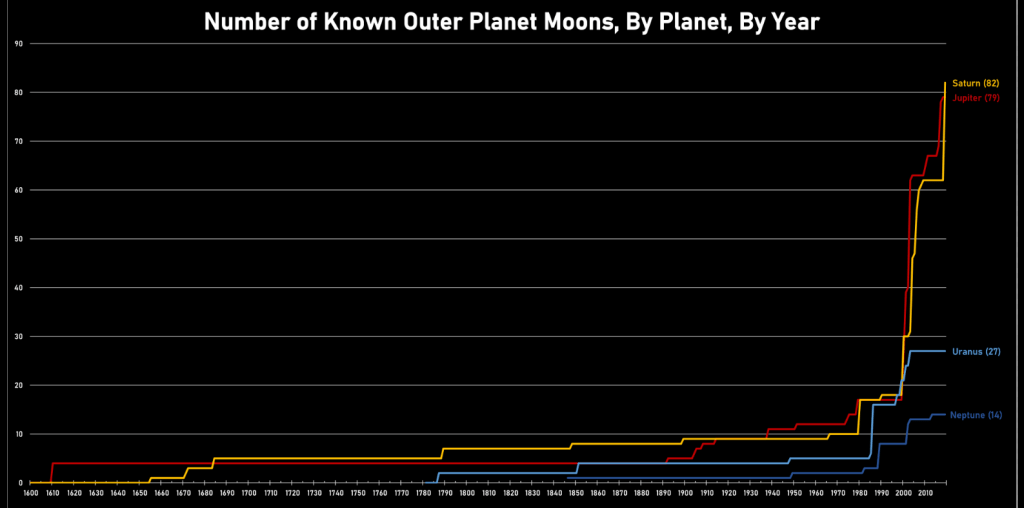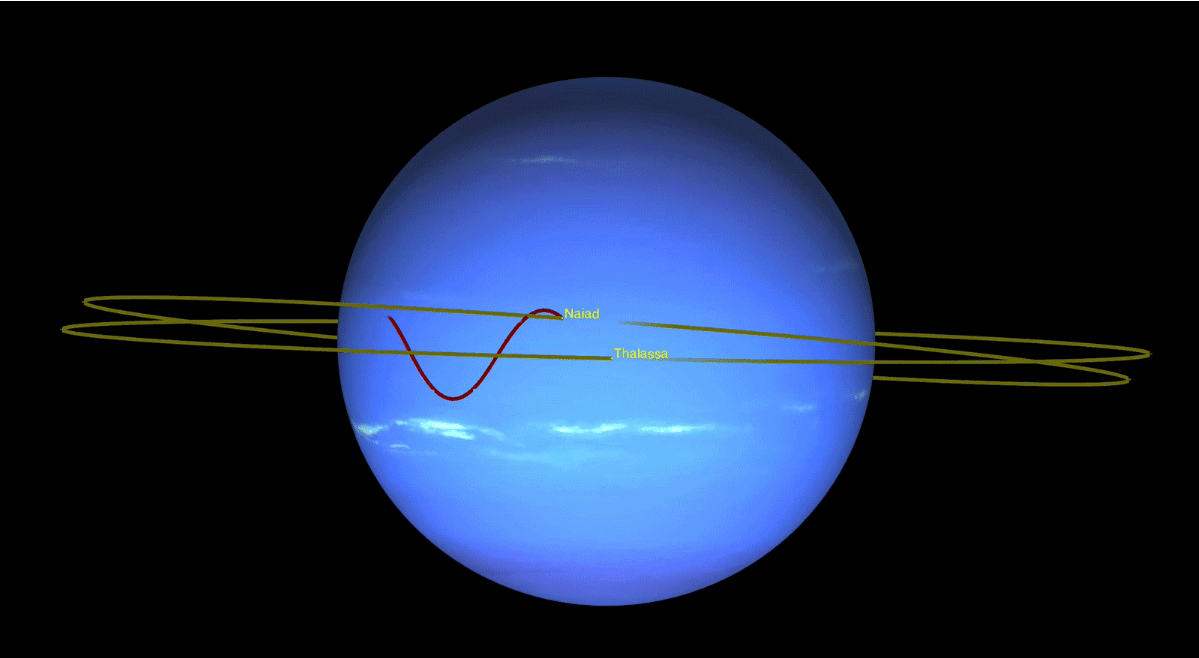Like a long-married couple accustomed to each other’s kitchen habits, two of Neptune’s moons are masters at sharing space without colliding. And though both situations may appear odd to an observer, there’s a certain dance-like quality to them both.
We’re talking about Thalassa and Naiad, two Neptunian moons discovered by Voyager 2 in 1989. The two moons are tiny, each one about 60 miles long, so they might be more accurately called moonlets. They’re the two closest moons to Neptune, with Naiad having the inside track.
They’re not round like larger bodies, and they’re both probably rubble-pile bodies, accreted out of fragments of some of Neptune’s larger moons. Those larger moons are long gone, likely destroyed by gravitational perturbations from Triton.

A new study sheds some light on the strange orbital dance performed by the pair, and suggests there’s nothing else like it in the Solar System. The study is titled, “Orbits and resonances of the regular moons of Neptune.” It was published in the journal Icarus on Nov. 13th. The lead author is Marina Brozovic, an expert in solar system dynamics at NASA’s Jet Propulsion Laboratory.
“There are many different types of ‘dances’ that planets, moons and asteroids can follow, but this one has never been seen before.”
Marina Brozovic, Lead Author, JPL.
Brozovic and the other authors found that Naiad and Thalassa are locked into an unusual orbital resonance. Though their orbits are only about 1850 km (1150 miles) apart, the two moons never get that close to each other. That’s because Naiad’s orbit is tilted. Naiad travels faster than Thalassa, and when the two pass each other by, they’re always about 3540 km (2200 miles) apart.
Naiad takes seven hours to orbit Neptune, while Thalassa takes seven and a half hours. A press release explains the odd situation well, saying, “An observer sitting on Thalassa would see Naiad in an orbit that varies wildly in a zigzag pattern, passing by twice from above and then twice from below.” That two-up, two-down pattern repeats itself every time that the inner moon Naiad laps Thalassa four times.
“We refer to this repeating pattern as a resonance,” said lead author Brozovic. “There are many different types of ‘dances’ that planets, moons and asteroids can follow, but this one has never been seen before.”
A Cryptozoology of Moons?
The outer Solar System is where you’d expect to find something like this. In the inner Solar System, the planet’s have one, two, or no moons. In fact there only three of them, with Mars’ moons Phobos and Deimos not much more than odd-shaped chunks of rock, while Earth’s moon is more like a ‘proper’ moon. But in the outer Solar System, the environment is much different.
Rather than the Sun, which dominates the inner Solar System, the giant gas planets dominate the outer system. They boast dozens of moons of all sizes and types. Jupiter has over 75 moons, and Saturn has over 80. Between the two of them, they have frozen moons with sub-surface oceans, a volcanic moon, a moon with liquid hydrocarbons on its surface, and even a moon that might have its own rings.

Neptune has 14 moons and Uranus has 27. Neptune’s moon Triton follows a retrograde orbit, meaning it orbits in the opposite direction to the planet’s rotation, unlike the rest of the planet’s moons. Meanwhile, Uranus has 9 irregular moons, 8 of which are retrograde. Some of the moons in the outer Solar System formed alongside their host planets, and some were captured later. There’s even a moon named Neso, whose elliptical orbit around Neptune takes it as far as 74 million km (46 million miles) away from its host planet. And it takes 27 years to do so.
So it’s kind of weird out there.
But labelling it as weird doesn’t help explain it. What happened to these two moons to produce this dazzling dance?
“We suspect that Naiad was kicked into its tilted orbit by an earlier interaction with one of Neptune’s other inner moons,” Brozovic said. “Only later, after its orbital tilt was established, could Naiad settle into this unusual resonance with Thalassa.”
“We are always excited to find these co-dependencies between moons,” said Mark Showalter, a planetary astronomer at the SETI Institute in Mountain View, California, and a co-author of the new paper. “Naiad and Thalassa have probably been locked together in this configuration for a very long time, because it makes their orbits more stable. They maintain the peace by never getting too close.”
In their paper, the authors say that their work is based on the most complete set of data available for these moons. The data includes Voyager observations, observations from Earth-based telescopes, and Hubble Space Telescope observations. All together the data spans from 1981 to 2016.
More:
- Press Release: NASA Finds Neptune Moons Locked in ‘Dance of Avoidance’
- Research Paper: Orbits and resonances of the regular moons of Neptune
- Universe Today: Triton’s Arrival was Chaos for the Rest of Neptune’s Moons

